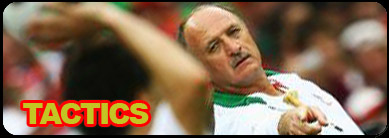 Tactics can be broken down in to two areas. First of all there are the tactics used to implement the principles of the game. You will see these occur all over the field of play.
Tactics can be broken down in to two areas. First of all there are the tactics used to implement the principles of the game. You will see these occur all over the field of play.
Then we have the teams tactics as a whole, these are what we as a team pre-plan to win the game. Offensive team tactics would normally be 1) counter attacking or 2) possession. Defensively you would consider 1) zone defending or 2) man-to-man.
So understanding the principles of attacking, lets look at one of the tactics used to implement this, the wall pass or one-two pass.
(Have a look at this video to see why it’s called the wall pass.)
In the video below we see it successfully executed twice on the left wing by Germany against Portugal in Euro 2008.
The attacker receives the ball and is immediately supported by a team mate that he can pass to.
The pass is made and the attacker looks to occupy the space behind the first defender to receive the return pass.
What they are actually doing is creating what we call numerical advantage, in this case a 2v1 situation.
If you pause the video at 17seconds you can see that after the first wall pass, the first attacker has beaten the first defender (is nearer the opponents goal than the defender) and is now attacking another defender behind him.
Because the first wall pass was so successful, and he has support from another team mate, he is again in a 2v1 situation to make another wall pass.
They execute this to perfection and he’s away to put in a cross to score a very good team goal.
This is probably the most basic tactic used to attack defenders.
Have a look here at J.A.Kings Strong Soccer for a reminder of the principles of play, followed by a great collection of examples of attacking tactics
These tactics and patterns of play can be practiced at again and again using drills on the training ground.
The move you see being practiced below we call “third man running”.
Have a look at Vierra scoring for Arsenal, do you notice any similarities?
So if we now look at the principles of defending and we have learned the lesson of the requirements of the first defender (the defender closest to the ball) in our technique/tackling section, then we can go on to understand the role of the second defender and the team tactics used to defend.
If you consider our defensive principles of play , in the video below we can see Argentina defending superbly against Brazil. This is done by the first defender applying pressure to the man on the ball, preventing him from shooting, or playing the ball forward. When the attacker passes the ball, the first defender “drops off” to prevent the first attacker getting behind him or a pass being played between him and the second defender. The second defender then immediately becomes the first defender, again putting pressure on the man with the ball.
Argentina’s defenders work extremely hard against a great Brazil team until 46secs in, where one defender chases the ball all the way back to the goalkeeper leaving a one man advantage to the attacking team behind him. The Brazil team expertly and efficiently expose the weakness with lightening speed.
Attacking TEAM tactics
Counter attacking:
In the next video below we can see the team in the yellow getting dispossessed deep in their opponents half. Once the ball is won by the red team, the attack happens very quickly. The ball is brought forward at speed and players support very quickly. After some final interchanges in front of their opponents goal the red team score a brilliant goal.
Teams will identify opponents weaknesses and use them to their advantage. If the team in yellow (in the above clip) were particularly poor at scoring from crosses, the red team may organise themselves to force play into the corners of the pitch, where they will be safe.
If the yellow team have been identified as being poor in these areas, the red team may designate this area as the point where they are most comfortable to force a transition and win the ball back. If it’s the yellow teams full-back that has been dispossessed, then that’s the space that the red team needs to attack before the yellow player has a chance to get back.
The counter attacking method requires a disciplined defence (usually zonal) to sit and wait and set their trap. It requires to allow the opposition to attack them in their own half, allowing the space behind them to be available to attack into once transition takes place.
Possession football:
This requires the team as a whole, to be confident in possession of the ball, to pass the ball to the man in space and keep it away from the opposition. It requires a lot of patience and belief. It needs movement of players off the ball to create space for team mates to move into. Should it break down, players will normally go man for man and try and win the ball back quickly and preferably in the opponents half.
Watch this video of Barcelona against Liverpool.
After a little while the Liverpool players (pushed on by the upset home fans) end up chasing the ball to win it back. This allows the Barcelona players to exploit the space that is eventually left and they score.





